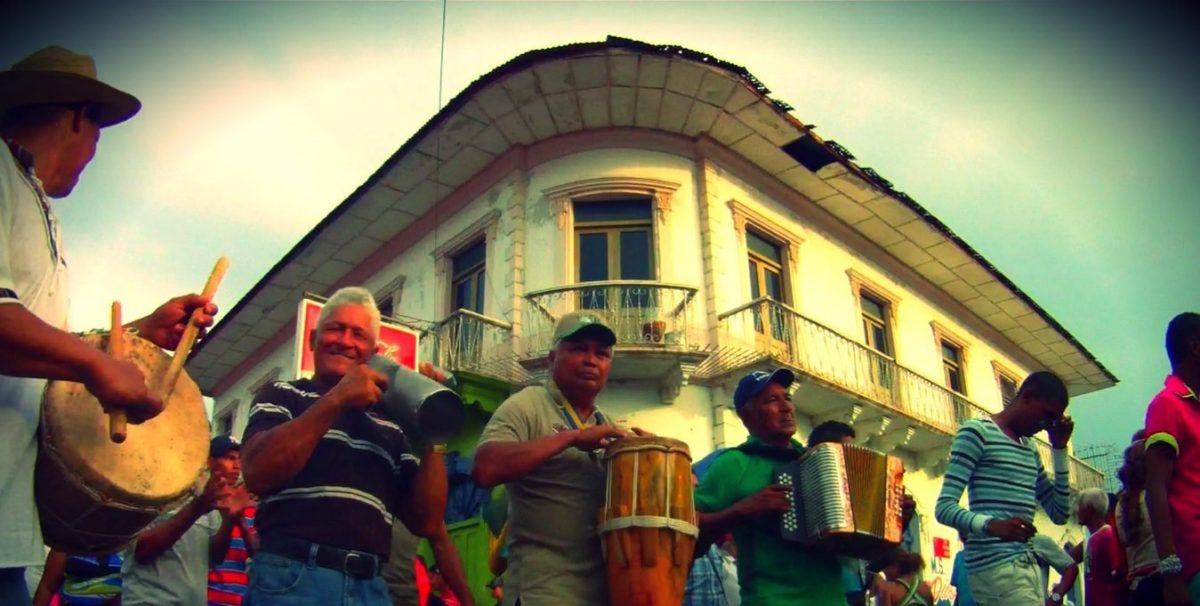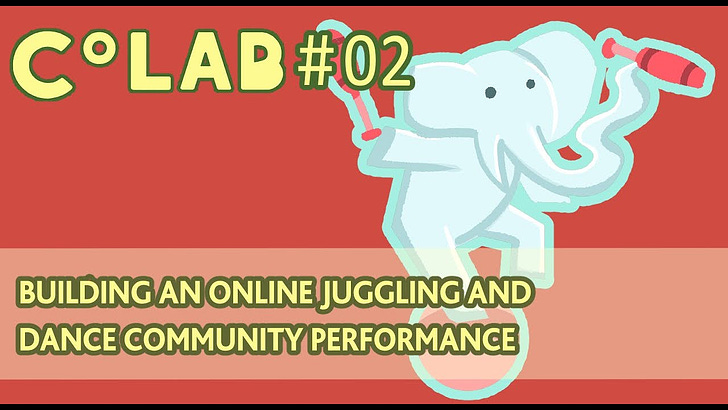Video version to go live on Saturday, 7pm UK Time.
In the Village
On a landscape of savannahs and rolling hills, upon a long and rich history of human habitation, sits the small village of La Villa de Los Santos. Located in the Azuero Peninsula of Central Panama, where Spanish colonial architecture meets archaeological sites and agrarian traditions, La Villa is often described as the cradle of all things Panamanian. A big hat to wear for a village that can be cycled from end-to-end in about 30 minutes.
Irina Ruiz Figueroa, filmmaker, engineer, director-producer, has been working in this small town since 2002. She and a collective of cultural industry experts have been pioneering methodologies in the use of documentary and non-fiction filmmaking as a way to rescue intangible heritage and traditions from the fog of “el olvido” - the space-action of being lost to memory.
ACAMPADOC is many things: a documentary film school, the only non-fiction film festival in Central America, a cultural exchange programme that reaches far afield. And, of course, a creative hub where film is a tool to safeguard local traditions.
La Villa “is a window for the region,” Irina tells us, where most of those identifying ideas of culture are reflected locally. This is something people who live there are keenly aware and protective of. The town of La Villa, as an imaginative hub and cradle of culture, has citizens who care a lot about safeguarding their traditions; for they know that, in the absence of government assistance, these traditions are the foundations of their future.
What is Heritage Filmmaking?
“We are also described as ‘public archaeologists’. As filmmakers in documentaries we are in contact with living culture, with living heritage and approach the facts, the situations, with a camera, with an audio recorder, and that has been characterised as public archeology since the 80s.”
Irina and her colleagues didn’t start out as heritage filmmakers. From the very beginning, the whole point was to educate and elevate talent. But in the process of taking their cameras out to the field with their students and making short films of five to seven minutes, they started capturing parts of the everyday traditions of the region that are now in danger of or have already disappeared.
“To rescue heritage through film has been something we never proposed to ourselves as a project. We started to give and share what we had with new filmmakers that wanted to make cinema, to access the knowledge.”
By elevating local and regional talent with local and regional interests, the filmmakers have inadvertently been safeguarding culture, traditions and activities that are at risk of disappearing from a myriad of menaces; youth brain drain, changing tides of economics, or a lack of government programmes for cultural promotion or protection. Suddenly, Irina and her colleagues found themselves sitting on a gold mine; an archive of films, records of traditions that have already been lost.
But why is a small team of creative practitioners spearheading a programme of cultural recovery, of living tradition safeguarding? The answer, like often is the case in Panama, is of weak institutions and a lack of decisive action. This vacuum creates risks. “If you’re not being sharp with a cultural policy of safeguarding, probably in another ten years you would lose what you were considering living culture, living heritage.”
And then what would be left to define a place, or a people?
“El olvido,” Irina says, “is the most dangerous thing. There is no way to revive tradition. And when you lose that tradition, you lose the identity. Forever.”
When I asked Irina about how ACAMPADOC is able to use film, an often-passive medium, to not just capture life as it is but also encourage community reflection, she said that it is all about making it relatable. An important part of their work is in their role as content producers. By showing real characters in real situations from La Villa, they can appeal to students and the local community by showing “specific issue[s] that they recognise”. Every year, the ACAMPADOC festival gives the community an opportunity to be reflected on the screen, something that helps them the chance to reflect on “that which is being or has been lost.”
And that is the power of cultural production, isn’t it? To see ourselves reflected in art To reflect ourselves in our own art and content and media. One could argue that this is all the more relevant in a Latin American context, where so much of our cultural heritage has been defined externally: through a white European colonial, and later white North American colonial, post-Monroe Doctrine filter. Someone else has defined us, even within our own countries.
“If you as a community do not value yourself, no one else is going to value what you have.”
Log-term Radical Community Building
Part of my reason for interviewing Irina and for bringing a story like hers to different audiences is to showcase the so-called “alternatives” to community organising that you often hear people speak of in high esteem. But what is alternative to some, is the way of life to others. Austerity may just over a decade old in most of Europe, but communities working together in the face of great economical, governmental and institutional challenges has been the rule for Panamanian groups for a long, long, long time. Irina and ACAMPADOC’s work is an example of what is possible, and perhaps can serve as a blueprint for others. Any such project, of course, takes time.
In the beginning, ACAMPADOC members, who came out of the Escuela Internacional de Cine y TV de Cuba, travelled to La Villa to teach children who didn’t have the same opportunities as they did - children not just from La Villa, but from other underrepresented places and regions. They have empowered indigenous filmmakers who want to create as a way to express themselves - to tell their own stories and their own histories. These are narratives that would never have been told otherwise; narratives that can help fight against oppression, bring environmental issues to the forefront of the cultural conversation, or preserve ways of life that Western conformity seeks to grind into commodities in the market.
“Remember that for Central America, there are no ways to learn how to do filmmaking, even though we have a very important filmmaking school in Cuba. But in Central America there’s no way to travel, no resources to travel, there are no funds in Central America. Countries have no Ministries of Culture. Panama is the only country that has a ‘fund for filmmaking’.” Irina brings out the air quotations when she says the last bit, suggesting a lot of unspoken relationships and faulty wiring at an institutional level.
This type of slow-burn community building is not something you can plan for, not entirely, and it is not something that you do within a year and then leave. A project like this has to be thought of on the scale of five or more years, Irina says.
Ten years ago, the first students arrived in La Villa from Nicaragua, Guatemala, Colombia, and Honduras, to receive training at ACAMPADOC. “They literally showed up covered in dust after hours and days of travel. They were heroes. These people were coming like mochileros – backpackers – by themselves. Kids with no credit card.”
Ten years later, those first students are now leaders in their respective countries, holding small film festivals, teaching, and making “amazing films” about contemporary issues. They oversee their own organisations, community projects, film studios and projects rescuing their communities’ collective knowledge. They are fulfilling one of ACAMPADOC’s objectives - that their model of heritage filmmaking can be applied in any place, any community. And those connections started in a small vilalge you can cycle across in less than 30 minutes.
“We call this the La Buena Semilla – the good seed – that we plant here at ACAMPADOC. We help those young people to make those projects and promote them with the communities.
“And this is the best thing about being in ACAMPADOC – we’re making cinema, teaching cinema, but also benefiting the community in a very strong way. Some years I think that the programme or ACAMPADOC can stop because we’ve done a lot - but it is the community that asks me to keep going, and comes to my door asking me to rescue this or rescue that.”
La Villa de Los Santos is an infinite quarry of stories.
I was planning to ask her about how she measures the impact of the films, but the fact that the community has cried out “come back, we need you” is evidence enough.
In the spirit of collaboration, I ask Irina a final question. What would she like our readers and listeners to do? She invites you to write to them, reach out, collaborate. Follow them on the socials or send them an email. And if you can, maybe visit the ceramic-roofed houses of La Villa and make your own documentaries alongside this team of dedicated artists.
Visit ACAMPADOC’s website: https://www.acampadoc.com/
Follow them on Twitter.










Heritage Preservation Using Community Documentary Film in Central America: CoLab 003